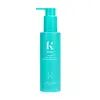What's inside
What's inside
 Key Ingredients
Key Ingredients

 Benefits
Benefits

 Concerns
Concerns

 Ingredients Side-by-side
Ingredients Side-by-side

Water
Skin ConditioningLauryl Glucoside
CleansingGlycerin
HumectantBetaine
HumectantHydroxypropyl Methylcellulose
Emulsion StabilisingPEG-7 Glyceryl Cocoate
EmulsifyingPhenoxyethanol
PreservativeSodium PCA
HumectantZinc PCA
HumectantSorbitol
HumectantCamellia Sinensis Leaf
PerfumingCentella Asiatica Extract
CleansingDipotassium Glycyrrhizate
HumectantHydrolyzed Sodium Hyaluronate
Skin ConditioningResveratrol
AntioxidantSodium Hyaluronate
HumectantAllantoin
Skin ConditioningDisodium EDTA
Serine
MaskingGlycine
BufferingPolysorbate 20
EmulsifyingSodium Lauroyl Lactylate
EmulsifyingGlutamic Acid
HumectantAlanine
MaskingArginine
MaskingLysine
Skin ConditioningHexylresorcinol
AntimicrobialIsopropyl Alcohol
SolventThreonine
Ceramide NP
Skin ConditioningProline
Skin ConditioningCeramide AP
Skin ConditioningCholesterol
EmollientPhytosphingosine
Skin ConditioningXanthan Gum
EmulsifyingCarbomer
Emulsion StabilisingCapric Acid
CleansingPEG-400
Emulsion StabilisingCeramide EOP
Skin ConditioningCamellia Sinensis Leaf Water
MaskingAlpha-Glucan Oligosaccharide
CleansingCaprylic Acid
CleansingCaproic Acid
CleansingWater, Lauryl Glucoside, Glycerin, Betaine, Hydroxypropyl Methylcellulose, PEG-7 Glyceryl Cocoate, Phenoxyethanol, Sodium PCA, Zinc PCA, Sorbitol, Camellia Sinensis Leaf, Centella Asiatica Extract, Dipotassium Glycyrrhizate, Hydrolyzed Sodium Hyaluronate, Resveratrol, Sodium Hyaluronate, Allantoin, Disodium EDTA, Serine, Glycine, Polysorbate 20, Sodium Lauroyl Lactylate, Glutamic Acid, Alanine, Arginine, Lysine, Hexylresorcinol, Isopropyl Alcohol, Threonine, Ceramide NP, Proline, Ceramide AP, Cholesterol, Phytosphingosine, Xanthan Gum, Carbomer, Capric Acid, PEG-400, Ceramide EOP, Camellia Sinensis Leaf Water, Alpha-Glucan Oligosaccharide, Caprylic Acid, Caproic Acid
Water
Skin ConditioningGlycerin
HumectantSodium Cocoyl Glycinate
CleansingSodium Lauroyl Glutamate
Sodium Hyaluronate
HumectantHyaluronic Acid
HumectantHydrolyzed Hyaluronic Acid
HumectantSodium Acetylated Hyaluronate
HumectantHydroxypropyltrimonium Hyaluronate
Hydrolyzed Sodium Hyaluronate
Skin ConditioningSodium Hyaluronate Crosspolymer
HumectantPotassium Hyaluronate
Skin ConditioningPanthenol
Skin ConditioningAllantoin
Skin ConditioningTrehalose
HumectantTocopherol
AntioxidantHamamelis Virginiana Extract
AntiseborrhoeicCamellia Sinensis Leaf Extract
AntimicrobialChamomilla Recutita Extract
Skin ConditioningButylene Glycol
HumectantDipropylene Glycol
HumectantHydroxypropyl Starch Phosphate
Glyceryl Stearate Se
EmulsifyingPotassium Benzoate
PreservativeSodium Chloride
MaskingPolyquaternium-67
Sodium Acetate
Buffering1,2-Hexanediol
Skin ConditioningCitric Acid
BufferingEthylhexylglycerin
Skin ConditioningDisodium EDTA
Malachite Extract
AntioxidantWater, Glycerin, Sodium Cocoyl Glycinate, Sodium Lauroyl Glutamate, Sodium Hyaluronate, Hyaluronic Acid, Hydrolyzed Hyaluronic Acid, Sodium Acetylated Hyaluronate, Hydroxypropyltrimonium Hyaluronate, Hydrolyzed Sodium Hyaluronate, Sodium Hyaluronate Crosspolymer, Potassium Hyaluronate, Panthenol, Allantoin, Trehalose, Tocopherol, Hamamelis Virginiana Extract, Camellia Sinensis Leaf Extract, Chamomilla Recutita Extract, Butylene Glycol, Dipropylene Glycol, Hydroxypropyl Starch Phosphate, Glyceryl Stearate Se, Potassium Benzoate, Sodium Chloride, Polyquaternium-67, Sodium Acetate, 1,2-Hexanediol, Citric Acid, Ethylhexylglycerin, Disodium EDTA, Malachite Extract
 Reviews
Reviews

Ingredients Explained
These ingredients are found in both products.
Ingredients higher up in an ingredient list are typically present in a larger amount.
Allantoin is a soothing ingredient known for its protective and moisturizingg properties. Because of this, it is often added to products with strong active ingredients.
Studies show higher concentrations of this ingredient can promote wound healing.
Though it can be derived from the comfrey plant, allantoin is produced synthetically for cosmetic products to ensure purity.
Learn more about AllantoinDisodium EDTA plays a role in making products more stable by aiding other preservatives.
It is a chelating agent, meaning it neutralizes metal ions that may be found in a product.
Disodium EDTA is a salt of edetic acid and is found to be safe in cosmetic ingredients.
Learn more about Disodium EDTAGlycerin is already naturally found in your skin. It helps moisturize and protect your skin.
A study from 2016 found glycerin to be more effective as a humectant than AHAs and hyaluronic acid.
As a humectant, it helps the skin stay hydrated by pulling moisture to your skin. The low molecular weight of glycerin allows it to pull moisture into the deeper layers of your skin.
Hydrated skin improves your skin barrier; Your skin barrier helps protect against irritants and bacteria.
Glycerin has also been found to have antimicrobial and antiviral properties. Due to these properties, glycerin is often used in wound and burn treatments.
In cosmetics, glycerin is usually derived from plants such as soybean or palm. However, it can also be sourced from animals, such as tallow or animal fat.
This ingredient is organic, colorless, odorless, and non-toxic.
Glycerin is the name for this ingredient in American English. British English uses Glycerol/Glycerine.
Learn more about GlycerinThis ingredient is created by putting sodium hyaluronate through hydrolysis.
You might know this as 'mini' or 'ultra low-molecular weight' hyaluronic acid. The small molecule size means it is able to travel deeper in the skin.
According to studies, low molecular-weight hyaluronic acid can:
One study from 2011 found ultra-low weight HA to show pro-inflammatory properties. Another study from 2022 found it to downregulate UV-B induced inflammation.
Hydrolysis is a process of changing a molecule using water or enzymes.
This ingredient is water-soluble.
Learn more about Hydrolyzed Sodium HyaluronateSodium Hyaluronate is hyaluronic acid's salt form. It is commonly derived from the sodium salt of hyaluronic acid.
Like hyaluronic acid, it is great at holding water and acts as a humectant. This makes it a great skin hydrating ingredient.
Sodium Hyaluronate is naturally occurring in our bodies and is mostly found in eye fluid and joints.
These are some other common types of Hyaluronic Acid:
Learn more about Sodium HyaluronateWater. It's the most common cosmetic ingredient of all. You'll usually see it at the top of ingredient lists, meaning that it makes up the largest part of the product.
So why is it so popular? Water most often acts as a solvent - this means that it helps dissolve other ingredients into the formulation.
You'll also recognize water as that liquid we all need to stay alive. If you see this, drink a glass of water. Stay hydrated!
Learn more about Water